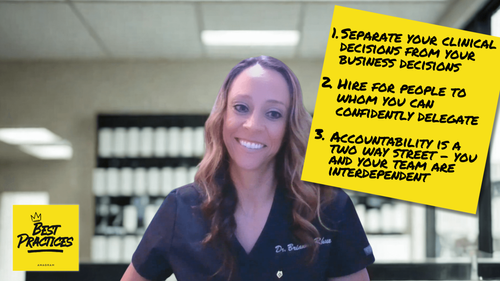Best Practices for Curating a Better Dispensary

Selecting eyewear collections for your optical goes beyond filling frame boards. It’s a process of learning what your patients respond to, how your team presents it, and what kind of impression your practice makes.
Importantly, this isn’t a one-time approach, rather it’s a cyclical process of understanding that should reinforce itself or be adjusted season over season as new information presents itself. Every visit, whether it’s your patient’s first or their fiftieth, is an opportunity to receive feedback from your most important advisors about what works and what doesn’t within your practice.
After listening to the most recent Best Practices Episode with host Steve Alexander and guests Zach Weaver and Jill Kielas of Tom Davies, I started thinking more critically about how optical choices tell a story about your brand in its entirety, from your core values, to your understanding of the people who walk through your door.
The optical is where design meets decision-making. It’s a place where numbers and nuance have to coexist if you want your inventory to do more than just fill space. This episode brought that idea into focus for me in a way that was both practical and creative.
Check Out the Episode Here

Seeing Beyond Style
I found the consistent emphasis all parties placed on truly understanding your demographic to be very insightful. Many practices assume they already know who their patients are, and maybe they’re even right in broad strokes. Suppose you take the time to study purchasing patterns, age ranges, gender distribution, or even color preferences, do you think the data would tell a different story?
It’s easy and quite tempting to rely on instinct and what you think you know about your customer, but without data to support your gut feelings, what you’re actually relying on is a series of assumptions. Instead, why not review frame boards through the lens of data? By identifying what actually sells versus what just looks good on display, each subsequent decision made is informed by results, not guesswork. A relatively simple change in tactics can help prevent redundancy and opens up space for collections that keep the optical feeling exciting, fresh, and balanced.
Taking this approach will allow you to tell a more nuanced story that once properly understood will lead to making better decisions for all aspects of your business, from your dispensary to your brand to the services you offer and beyond.
Designing the Experience
Merchandising in eyecare is, unfortunately, often overlooked. I found it interesting to learn how frame placement and your customers’ physical journeys can influence buying behavior. A few small shifts in layout, like grouping by lifestyle or creating focal points for premium collections, can completely change how patients engage with the optical.
Successful retail businesses strive to curate a visual flow that makes exploration natural and comfortable. This organic presentation contributes to improving both sales and patient experience. It’s a reminder that optical design is an extension of your intention: if you make the experience effortless and enjoyable, people respond.
Reframing the Conversation and Building Buy-In
Another takeaway for me was the idea of reframing eyewear from something that simply holds lenses to being an integral part of someone’s lifestyle and not simply a single purchase. It serves as a reminder that glasses can be functional and expressive at the same time.
When opticians help patients see eyewear as an extension of their personality, it encourages curiosity and multiple-pair conversations without feeling like a heavy-handed sales pitch. When practices adopt this mindset, it changes the energy in the optical to become more about discovery and less about transaction.
Decisions can’t live in a vacuum, and involving opticians in the selection process creates ownership. When team members have a say, they advocate more naturally for the frames they helped choose. That sense of shared investment carries through to the patient experience. It reminded me that data may guide decisions, but people bring them to life.
Intentional Inventory, Intentional Outcomes
I have come to the conclusion (and I hope you all have too) that building the right optical comes down to balance: using data to shape instinct and creativity to bring structure and purpose together. Your number one goal should be to curate an experience that feels aligned with your practice identity and your patients’ needs, then focus on the “nice to haves” after.
I left this episode thinking about how every optical space reflects a philosophy. When each frame has a reason to be there, the result is an intentional representation of your practice’s story. And that, in the end, is what keeps patients coming back.



